The Multi-Part Identifier Could Not Be Bound
In SQL (Structured Query Language), a multi-part identifier refers to a reference to a database object that consists of multiple parts, such as a table or column name, separated by periods. This identifier is used to specify the exact location of the object within the database hierarchy, allowing for more precise querying and manipulation of data.
Common causes of the “multi-part identifier could not be bound” error
The “multi-part identifier could not be bound” error is a common issue that SQL developers encounter. This error is typically encountered when attempting to reference a database object using a multi-part identifier that cannot be found or resolved. Some common causes of this error include:
1. Typographical errors: One of the most common causes of this error is simply misspelling a table or column name within the multi-part identifier. Any small mistake in the name will result in the identifier not being able to be bound.
2. Incorrect table or column aliasing: When using table or column aliases in a SQL query, it is important to ensure that the aliases are used consistently throughout the query. A mismatch in alias usage can lead to the error message.
3. Missing or incorrect database qualification: If the multi-part identifier does not include the appropriate database qualification, the SQL engine may not be able to locate the specified object. It is important to ensure that the identifier includes the correct database name if working with multiple databases.
4. Nested queries or subqueries: When using nested queries or subqueries, it is important to properly reference the outer query’s table and column names within the inner queries. Failure to do so can result in the multi-part identifier not being bound.
Analyzing the syntax of the multi-part identifier in SQL queries
To analyze the syntax of a multi-part identifier in SQL queries, it is essential to understand how it is structured. The general format of a multi-part identifier is as follows:
database_name.schema_name.table_name.column_name
Each part of the identifier is separated by a period. The database name refers to the specific database within which the table resides. The schema name, optional in some database systems, refers to a logical grouping or namespace for tables. The table name identifies the specific table, while the column name specifies the column within the table.
In SQL queries, the multi-part identifier is typically used to reference the table or column name within the query, allowing for data manipulation or retrieval. However, it is crucial to ensure that the identifier is correctly formed, properly spelled, and exists within the given database.
Troubleshooting techniques for resolving the error
Resolving the “multi-part identifier could not be bound” error requires methodical troubleshooting. Here are some techniques to help address the issue:
1. Double-check the spelling and associated database: Verify that the multi-part identifier is spelled correctly and includes the appropriate database qualification if required. Even a minor typo can lead to the error, so careful attention to detail is essential.
2. Check for proper alias usage: If aliases are being used in the query, ensure that they are properly implemented throughout the entirety of the query. Inconsistent or incorrect alias usage can prevent the identifier from being bound.
3. Verify the existence of the object: Confirm that the table or column being referenced by the multi-part identifier actually exists in the database. If it does not exist, the identifier cannot be bound.
4. Examine the scope of the identifier: Determine if the multi-part identifier is being referenced in the correct scope or context. For example, if the identifier is being used in a nested query, ensure that the outer query’s table and column names are referenced correctly.
5. Utilize database management tools: Database management tools, such as SQL Server Management Studio, provide functionality to browse and explore the database structure. Use these tools to visually inspect the database hierarchy and confirm the existence and naming of the objects being referenced.
How to properly define and use aliases to resolve the error
Aliases can be used in SQL queries to provide a shorthand reference to tables or columns. They can also help address the “multi-part identifier could not be bound” error. Here’s how to properly define and use aliases:
1. Define aliases using the AS keyword: When defining aliases, use the AS keyword followed by the desired alias name. For example:
SELECT t.column_name AS alias_name
FROM table_name AS t
2. Use aliases consistently throughout the query: After defining an alias, ensure that it is used consistently throughout the query. Use the alias instead of the original table or column name in all subsequent references.
3. Verify correct alias usage within subqueries: When using nested queries or subqueries, correctly reference the outer query’s table and column names within the inner queries. To do this, use the alias of the outer query appropriately.
Addressing the issue of ambiguous column names in SQL queries
The issue of ambiguous column names arises when multiple tables in a query have columns with the same name. This can lead to the “multi-part identifier could not be bound” error. To address this issue:
1. Use explicit table aliases: When joining multiple tables in a query, use explicit table aliases to differentiate between columns with the same name. For example:
SELECT t1.column_name, t2.column_name
FROM table1 AS t1
JOIN table2 AS t2 ON t1.id = t2.id
2. Reference the column using the table alias: In queries where multiple tables are involved, reference columns using their appropriate table alias to avoid ambiguity. For example, use “t1.column_name” instead of only “column_name”.
Resolving the error when working with table joins and aliases
When working with table joins and aliases, it is crucial to ensure that the multi-part identifier can be bound correctly. Follow these steps to resolve the error in such scenarios:
1. Verify the proper aliasing of tables: When joining tables, ensure that each table has a unique alias. Additionally, confirm that the aliases are used consistently throughout the query.
2. Use the correct alias in the join condition: When specifying the join condition, use the alias of the tables being joined to ensure the condition is written correctly. Failure to do so may result in the identifier not being bound.
Best practices to prevent the “multi-part identifier could not be bound” error in future development
To prevent the “multi-part identifier could not be bound” error in future development, it is crucial to follow these best practices:
1. Double-check all object names: Pay close attention to spelling and correct casing when referencing tables, columns, or other objects. Typos, even small ones, can lead to the error.
2. Use consistent aliases: When using aliases, ensure they are used consistently throughout the query. Mismatches or inconsistencies can result in the identifier not being bound.
3. Avoid ambiguous column names: Try to use descriptive and unique names for columns in different tables to prevent ambiguity. If the same column name is used in multiple tables, use explicit aliases to differentiate them.
4. Regularly test and review queries: Regularly test and review queries to identify potential errors or issues. This can help catch and resolve any “multi-part identifier could not be bound” errors before they impact production systems.
By following these best practices, developers can minimize the occurrence of the “multi-part identifier could not be bound” error and improve the overall quality and reliability of their SQL queries.
Mssql How To Fix Error The Multi Part Identifier Could Not Be Bound
Keywords searched by users: the multi-part identifier could not be bound SQL the multi part identifier, The multi part identifier could not be bound update, Msg 4104, JOIN with multiple conditions SQL, SQL update multiple rows from SELECT, SELECT multiple table, With SQL Server, SELECT INTO
Categories: Top 65 The Multi-Part Identifier Could Not Be Bound
See more here: nhanvietluanvan.com
Sql The Multi Part Identifier
Structured Query Language (SQL) is a powerful tool used in managing and manipulating relational databases. It provides a standardized language for interacting with databases and retrieving information. One important concept within SQL is the multi-part identifier, which allows us to specify the location of a column or a table within a database. In this article, we will explore the ins and outs of the multi-part identifier in SQL and delve into some frequently asked questions.
Understanding the Multi-Part Identifier
In SQL, a multi-part identifier is a combination of identifiers separated by dots. It is used to refer to a specific column or table within a database. The multi-part identifier follows a hierarchical structure, starting from the outermost object and drilling down to the innermost object. For example, consider the following multi-part identifier: “database.table.column”. Here, “database” refers to the name of the overall database, “table” represents a specific table within that database, and “column” is a column within that table.
The use of multi-part identifiers becomes crucial when dealing with complex databases that involve multiple tables with similar column names. By specifying the entire path to the desired column, we eliminate any ambiguity and ensure that the correct data is retrieved or manipulated.
Resolving Ambiguity with Joins
One common scenario where multi-part identifiers are essential is during joins between multiple tables. When joining tables, we might encounter columns with the same name in both tables. If we don’t use multi-part identifiers to qualify the column, SQL will raise an error due to ambiguity. By including the table name as part of the identifier, we specify the exact location of the column, enabling SQL to determine which column we are referring to and avoiding any ambiguity.
For instance, let’s say we have two tables: “Customers” and “Orders,” both of which contain a column called “ID.” If we want to retrieve the “ID” column from the “Customers” table, we use the multi-part identifier “Customers.ID” to ensure that SQL fetches data from the correct table. Failure to use multi-part identifiers in such situations can lead to unexpected results or even SQL errors.
Handling Complex Queries and Subqueries
Multi-part identifiers become even more important when dealing with complex SQL queries and subqueries that involve multiple levels of table referencing. In such cases, ensuring the correct execution of queries heavily relies on the proper usage of multi-part identifiers.
Consider a situation where we have multiple tables linked by foreign keys, and we need to retrieve data from related tables. Using multi-part identifiers, we can specify the exact relationships between tables and their respective columns, enabling us to construct accurate and efficient SQL queries. Failing to provide the necessary multi-part identifiers might lead to incorrect or incomplete results.
FAQs about Multi-Part Identifiers in SQL
Q: Can I use aliases with multi-part identifiers?
A: Yes, aliases can be used to simplify the referencing of columns or tables within a database. Aliases act as shorthand for longer table or column names and can be utilized in conjunction with multi-part identifiers.
Q: How deep can multi-part identifiers go?
A: The depth of multi-part identifiers depends on the complexity and structure of the database. In theory, there is no limit to the number of levels a multi-part identifier can have.
Q: Can multi-part identifiers include schema names?
A: Absolutely! When dealing with multiple schemas within a database, it is common to include the schema name as part of the multi-part identifier to avoid ambiguity.
Q: Can multi-part identifiers be used in all SQL statements?
A: Yes, multi-part identifiers can be used in various SQL statements, including SELECT, UPDATE, DELETE, and JOIN statements.
Conclusion
Understanding and correctly using multi-part identifiers is crucial when working with complex databases and writing sophisticated SQL queries. By providing the full path to a column or table within a database, we eliminate ambiguity and ensure the accurate retrieval or manipulation of data. Remember to use multi-part identifiers when joining tables, handling complex queries, or referencing columns and tables across multiple levels. By doing so, you will harness the full potential of SQL and achieve optimal results in your database operations.
The Multi Part Identifier Could Not Be Bound Update
When working with databases, it’s not uncommon to encounter various errors and issues. One such error that can be frustrating to deal with is “The multi-part identifier could not be bound” update error. For those who are not familiar with database terminology, this error message can be quite confusing and intimidating. However, with a little understanding and knowledge about this issue, resolving it becomes a lot easier. In this article, we will dive deep into the reasons behind the “multi-part identifier could not be bound” update error and explore ways to fix it.
Understanding the Error:
The error message “The multi-part identifier could not be bound” often occurs when attempting to update a record in a SQL database. It essentially means that the identifier, which consists of multiple parts such as table name and column name, cannot be recognized or resolved by the SQL engine. In simple terms, the database engine fails to locate the specific object or identifier you are trying to access or manipulate.
Possible Causes:
1. Incorrect Table Alias: One common cause of this error is using an incorrect table alias. When performing an update query with aliases, it is crucial to ensure that the alias used matches the one defined in the query correctly. Mismatched aliases can lead to confusion and the “multi-part identifier could not be bound” error.
2. Misspelled Column Name: Another cause of this error is misspelling a column name while updating a record. SQL is case-insensitive by default; however, it’s essential to check for any differences in spelling, such as typos or incorrect capitalization, as they can result in the error.
3. Scope Issues: The error can also occur due to scoping problems when referencing a column from a table that is not part of the current context or query. It is vital to ensure that the tables and columns are properly joined and available within the scope of the update query.
4. Ambiguous Column Reference: If the database contains multiple tables with the same column name, the SQL engine may not be able to determine which table the column should be updated in. In such cases, using proper table aliases in the update query can help resolve the error.
5. Missing Object: The error can be triggered if the referenced object, such as a table or column, does not exist in the database. Double-checking the database schema and verifying the existence of the object can help identify and resolve the issue.
How to Resolve the Error:
1. Verify Aliases: Check all aliases used in the update query and ensure they are correctly defined and match the original table or column names.
2. Review Column Names: Carefully inspect all column names involved in the update query. Pay attention to any typos or inconsistencies. Correcting the column names to match the actual names in the database can fix the error.
3. Check Joins and Scopes: If the error arises from scoping issues or ambiguous column references, review the query’s joins and ensure that all tables and columns are appropriately referenced within the context of the update statement. Adjusting joins or using table aliases can help clarify the references and resolve the error.
4. Validate Object Existence: If the error persists, verify the existence of the referenced object, such as a table or column, in the database. Correcting any missing or wrongly referenced objects can eliminate the error message.
FAQs:
Q: Can this error occur in other database systems besides SQL?
A: While the specific error message may vary between database systems, similar issues related to identifiers not being bound or recognized can occur.
Q: Are there any tools or software that can help identify and resolve this error automatically?
A: Yes, various database management tools and IDEs offer features like syntax highlighting, code analysis, and debugging tools, which can help identify and fix such errors efficiently.
Q: What preventive measures can be taken to avoid encountering this error?
A: It is always recommended to double-check the SQL queries and ensure correct table and column names are used. Utilizing meaningful aliases, maintaining a consistent naming convention, and thorough testing can help prevent this error from occurring.
Q: Can this error impact data integrity or the overall functioning of the database?
A: The “multi-part identifier could not be bound” error is associated with query execution and does not directly impact data integrity or the functionality of the database. It is, however, important to timely resolve such errors to ensure the smooth operation of database operations.
In conclusion, the “multi-part identifier could not be bound” update error can be caused by various issues such as incorrect aliases, misspelled column names, scoping problems, ambiguous references, or missing objects. By diligently reviewing and rectifying the queries, taking into account the discussed causes and potential fixes, this error can be overcome with ease. Remember, a well-maintained and accurately referenced database is key to smooth data management and retrieval.
Msg 4104
Introduction:
SQL Server is a popular and powerful relational database management system, widely used by organizations to store and manage their data effectively. However, like any software, it may encounter errors that require attention and troubleshooting. One such error is SQL Server Error Message 4104. In this article, we will dive into the specifics of this particular error message, explore its causes, suggest potential solutions, and address frequently asked questions to help you better understand and resolve this issue.
Understanding SQL Server Error Message 4104:
SQL Server Error Message 4104 occurs when a query tries to refer to a column name that does not exist in the specified table. This error message usually reads as follows:
“Error 4104. The multi-part identifier ‘[Column_Name]’ could not be bound.”
This error message indicates that the specified column name, as mentioned in the query, does not exist or is misspelled within the target table. As a result, SQL Server fails to bind the identifier to an appropriate column, leading to this error.
Causes of SQL Server Error Message 4104:
1. Misspelled or non-existent column name: One of the primary reasons for this error is when the column name mentioned in the query is misspelled or does not exist in the target table. It is crucial to cross-check the column name and ensure its accuracy.
2. Ambiguous column reference: Another cause of Error 4104 can be an ambiguous column reference, occurring when the same column name exists in multiple tables or when the table alias is missing. SQL Server gets confused about the exact column to refer to, resulting in this error.
3. Corrupt system tables: In rare cases, corruption in SQL Server system tables might lead to this error. If the system metadata related to the table and column information is altered or damaged, SQL Server might struggle to bind the correct identifier.
Solutions to SQL Server Error Message 4104:
1. Verify column name: Double-check the column name in your query, ensuring it accurately reflects the target table’s column name. Spelling mistakes or case sensitivity issues should be rectified to avoid this error.
2. Qualify the column name: If the column name exists in multiple tables, explicitly qualify it using the table name or an appropriate alias. For example, instead of using just “Column_Name,” use “TableA.Column_Name” to provide the necessary clarification to SQL Server.
3. Use table aliases: Always utilize table aliases in your queries, especially when referencing columns from multiple tables. Aliases help disambiguate column names, assisting SQL Server in correctly binding the identifier to the intended column.
4. Check database integrity: In case you suspect corruption in your database or system tables, conduct a database integrity check using SQL Server tools like DBCC CHECKDB. If corruption is detected, you should address it promptly through appropriate maintenance measures.
SQL Server Error Message 4104 FAQ:
Q1: Can this error occur during joins or subqueries?
A1: Yes, Error 4104 can occur when joining or using subqueries, especially when column references are ambiguous or misidentified across tables.
Q2: Why does this error persist even when I’m confident the column name is correct?
A2: Sometimes, column names may collide with SQL Server reserved keywords, requiring you to enclose the column name within square brackets ([]). Ensure you are not using any reserved keywords as column names.
Q3: I am using views in my query, could that be the cause?
A3: Yes, this error can occur when working with views, particularly if any of the columns referenced in the view’s definition no longer exist in the underlying tables.
Q4: Can this error be caused by triggers?
A4: While it is uncommon, this error can be caused by triggers if the column referenced in the trigger action is not valid or has been removed from the table structure.
Q5: Is there any other error code similar to 4104?
A5: Yes, Error 207 is somewhat similar and occurs when a column name is not found or is misspelled. However, Error 207 specifically applies to stored procedures.
Conclusion:
SQL Server Error Message 4104 can be an obstacle in successful query execution. Understanding the causes and employing the suggested solutions mentioned in this article will help you resolve this error effectively. By ensuring accurate column names, qualifying them in case of ambiguity, and maintaining database integrity, you can minimize the occurrence of this error, improving the overall performance and reliability of your SQL Server environment.
Images related to the topic the multi-part identifier could not be bound

Found 46 images related to the multi-part identifier could not be bound theme












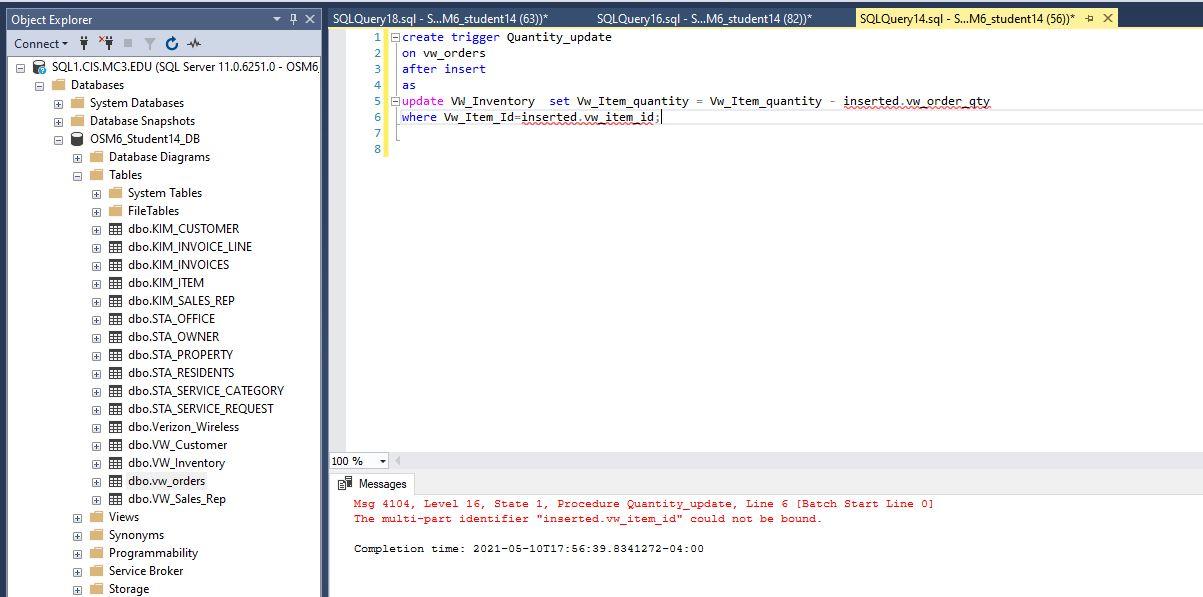
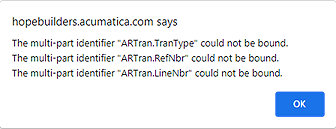

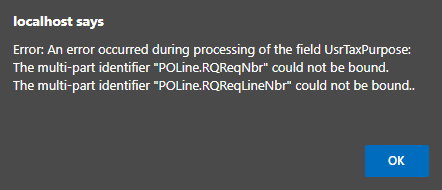




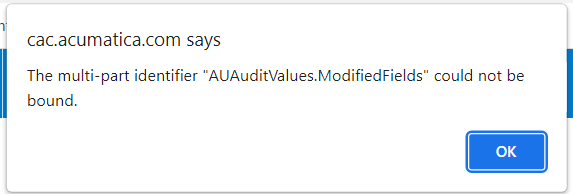
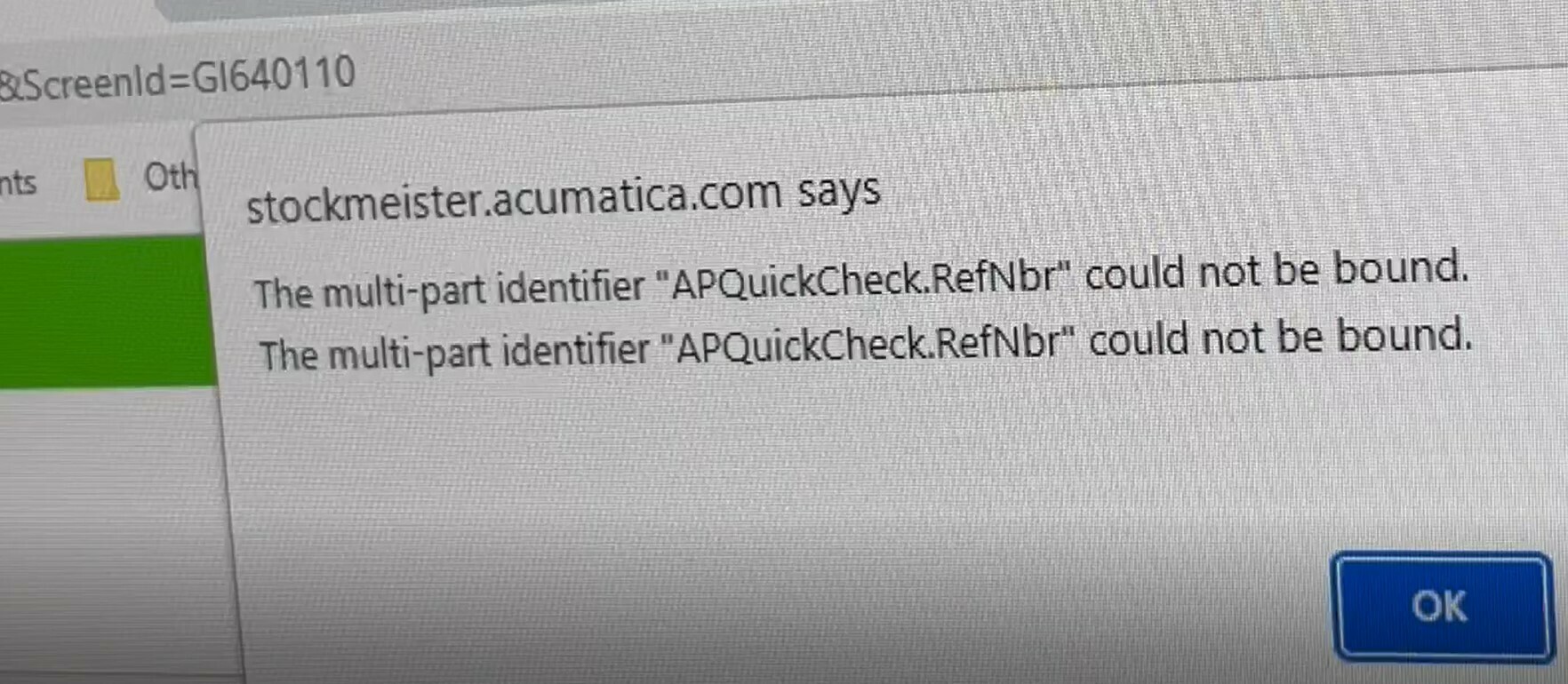











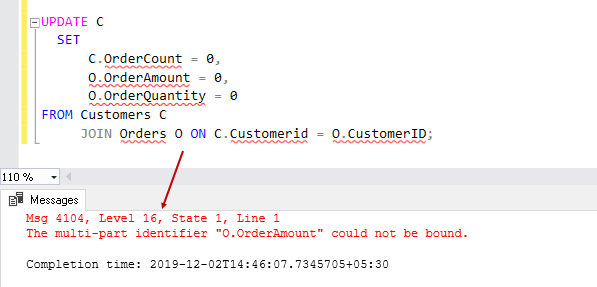
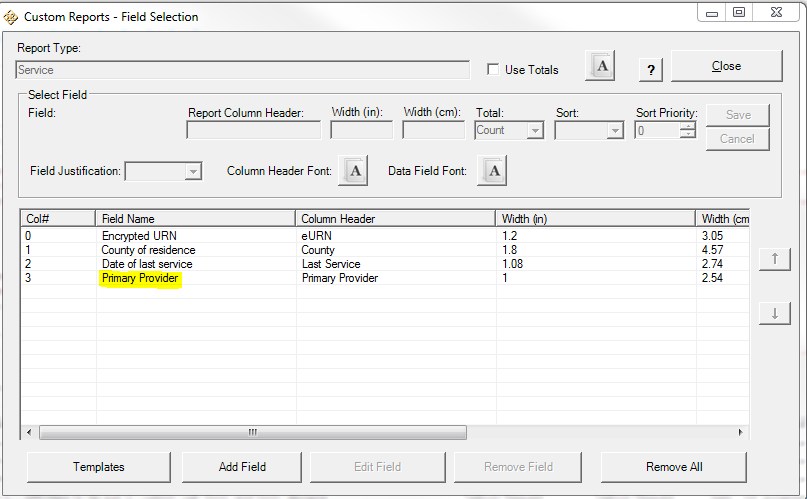










Article link: the multi-part identifier could not be bound.
Learn more about the topic the multi-part identifier could not be bound.
- The multi-part identifier could not be bound – Stack Overflow
- SQL Server Error 4104: The multi-part identifier could not be …
- The Multi Part Identifier Could Not Be Bound: Causes and Fixes
- The multi-part identifier could not be bound error.
- multi-part identifier could not be bound [closed]
- Lưu trữ Top 48 The Multi-Part Identifier Could Not Be Bound.
- the multi-part identifier could not be bound (sql error = 4104)
- multi-part identifier “t1.__RowNumber__” could not be bound.
- Error: Multi-part Identifier cannot be bound – SAP Answers
- Fixing the error: The multi-part identifier … could not be bound …
See more: nhanvietluanvan.com/luat-hoc